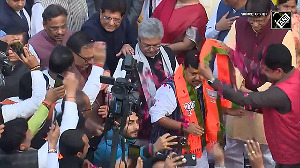Sachin Tendulkar may have opted for surgery on his troublesome tennis elbow as a last resort.
The master batsman, who has been bothered by the injury for over a year now, was operated upon by Dr Andrew Wallace at The Hospital of St John & St Elizabeth in London on Tuesday.
- Also read: Is Chappell correct about Sachin?

Tendulkar may not regain earlier form: Chappell
The decision to go under the knife was sudden, as it seemed Tendulkar had recovered from the injury when he made himself available for the recent series against Pakistan.
Professor Bruce Elliott, an authority on biomechanics at the University of Western Australia, told rediff.com on Wednesday that Tenduklar may been compelled to go under the scalpel as conservative exercise prescriptions were unable to relieve the pain he could have been experiencing.
"People don't have surgery on their elbows for tennis elbow unless other more conservative methods have failed.
"Often, with tennis elbows, exercise is the treatment to start with to try and stretch the area. If there is inflamation in the region, then you take injections to reduce the inflamation.
"Injections are quite common; exercise too is common to try and remove the pain from the region. If these don't alleviate the pain and don't let the person perform in the way he wants to perform or in the way he performed before, then doctors recommend surgery."
Elliott said Tendulkar could have been playing in pain all through.
"It was probably annoying him. It was either painful or it was causing him to modify his movements. So they would be the only two reasons presumably to go to the next step. One would be the pain and one would be that he had to modify his movements, which were obviously influencing his batting," he added.
The biomechanics expert said such injuries are not widespread in cricket.
"Tennis elbow is not common in cricket; it is more certainly common in tennis than in cricket. But it is like anything; you can get it in golf also, on different sides of the elbow.
"So different sports have the strain on one side of the elbow or the other side of the elbow, and, obviously, Sachin has hurt his elbow in the same way as a tennis player and that's where it is case of a tennis elbow."
Elliott also felt that the injury may have not healed completely because of the heavy bat the 32-year old uses.
"When he came back after the injury he was using his bat and hitting a lot of balls that were bowled to him in the nets. Obviously, with the heavy bat -- and in wet conditions the balls are also heavy -- it puts extra strain on the elbow region, particularly if he was hitting lots and lots of balls in the nets."
Elliott, whose field of research besides tennis and cricket covers kayaking, rowing and running, said "the injury is not career-threatening".
"Tendulkar can overcome it. It's like most overuse injuries. They happen and you can get over them. They are usually not career-threatening at all.
"It's one that a person can get over. It's an inconvenience over a period of time. If you look at tennis players, they normally recover with a small amount of rest, and with proper treatment they typically can perform again as well as they ever did."
Elliott was of the opinion that Indian team physiotherapist John Gloster, who is with Tendulkar in London, has an important role to play in the batsman's recovery.
"Once the surgeon and doctor have told the physio when he can start putting Tendulkar through a programme, then his job is absolutely critical.
"The physio has to monitor the exercises and the amount of practice that Tendulkar goes through during the recovery period," he concluded.





